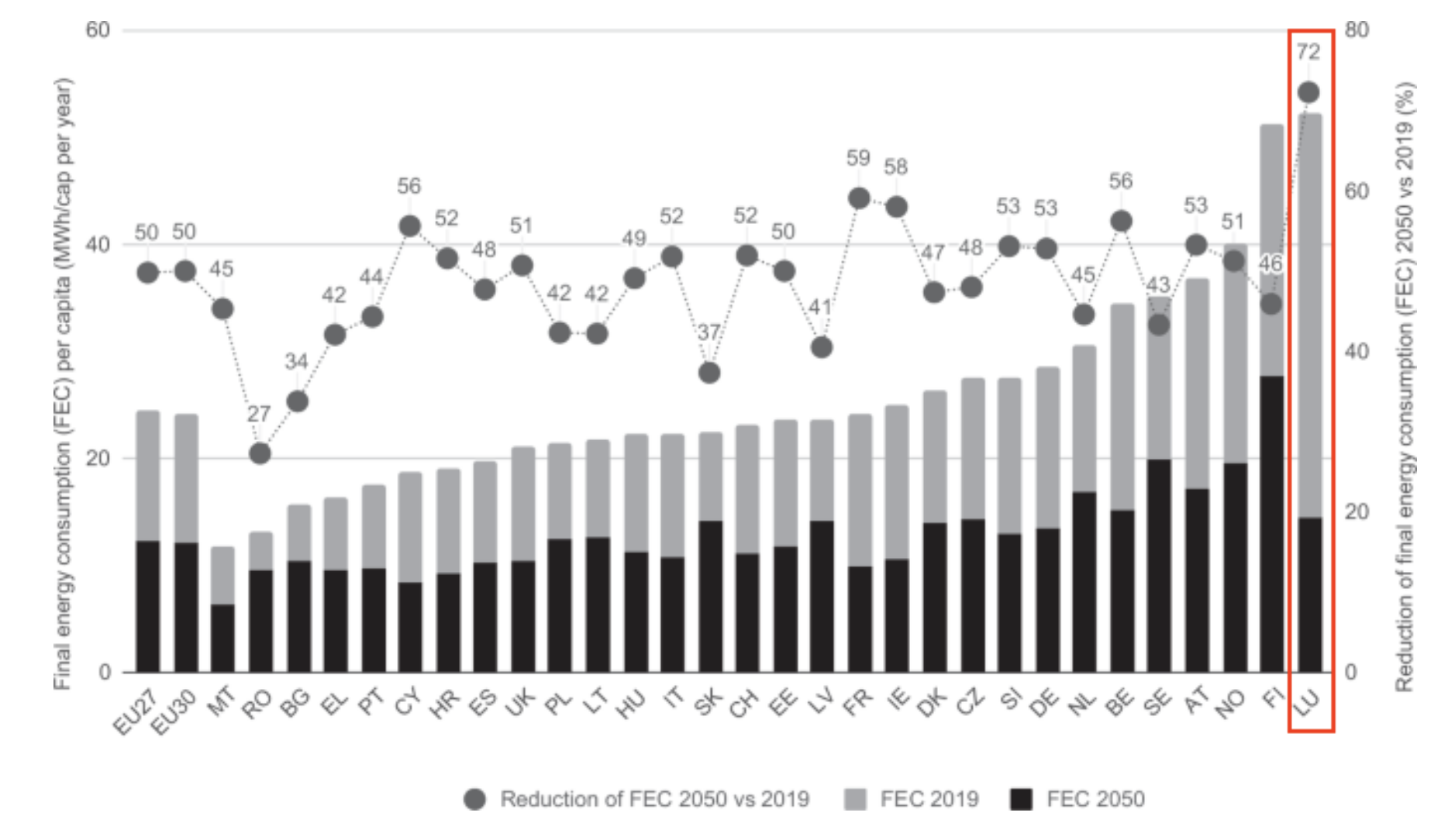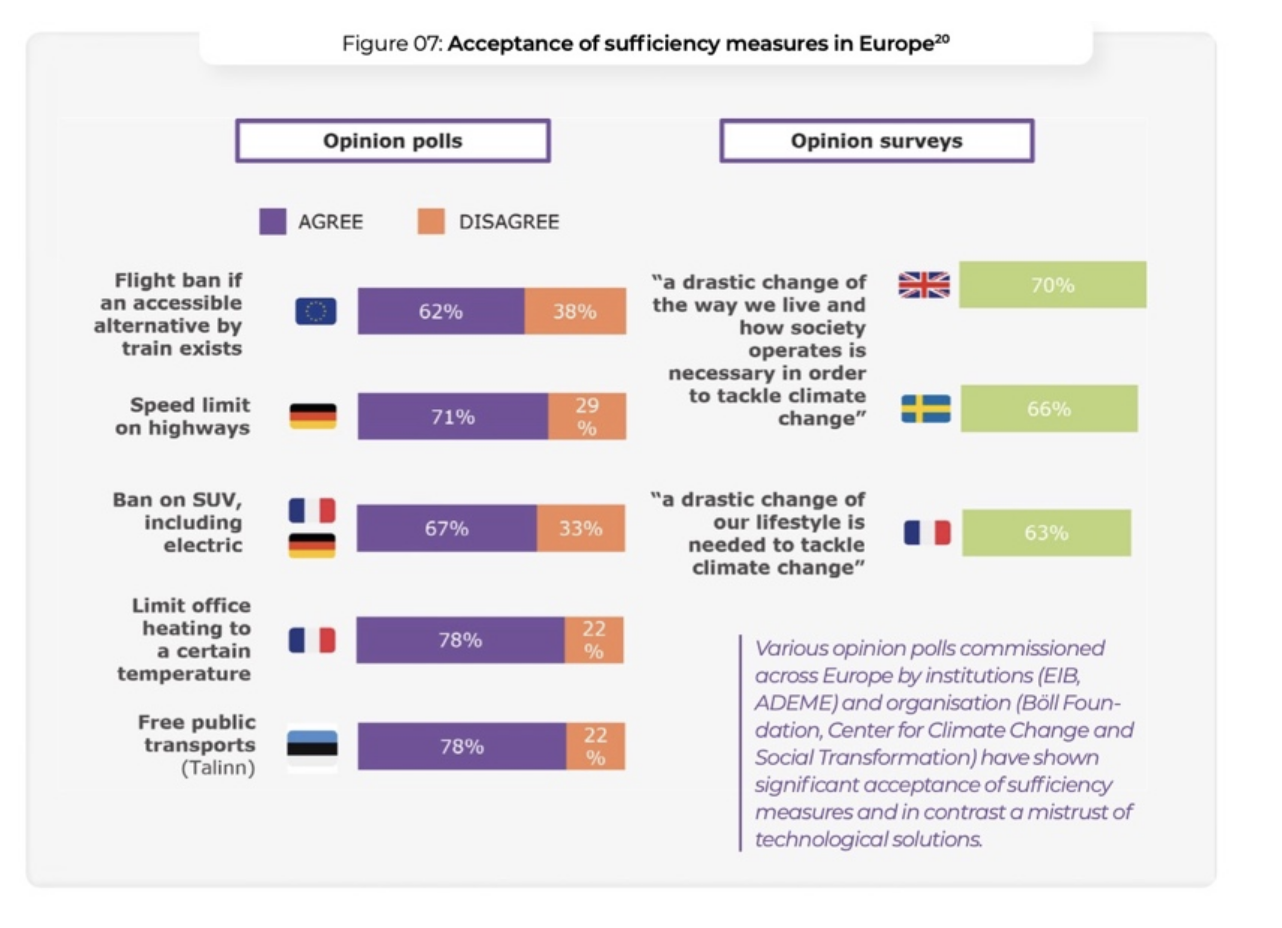The CLEVER energy scenario: CELL partner observes work demonstrating the impact of sobriety
10 min reading

A European energy transition scenario emphasizing sobriety
The European scenario of energy transition CLEVERof which CELL is the Luxembourg observing partner along with LIST, has just been the subject of a publication in Nature [1]. This scenario is the result of the coordination of several teams across Europe to draw up national trajectories, which are then compiled into a European trajectory. Its distinctive feature is its focus on the reducing energy consumption directly at the demand level. These sources of energy to be saved can be grouped together under the concept of sobriety, which the authors define as follows: "reducing consumption and production of end-use products and services through changes in social practices (supported by adequate infrastructures and frameworks), in order to stay within the planet's limits while guaranteeing a decent social base for all individuals"..
Alongside energy efficiency (your energy-efficient dishwasher, for example, consumes less for the same service) and the development of low-carbon energies, sobriety completes a complementary triptych. Indeed, a growing number of institutions, including the European Union, the IPCC and the International Energy Agency, are asserting that these demand reductions are essential if we are to achieve our climate objectives. However current strategies do not usually focus solely on efficiency and low-carbon energies. Sobriety is still struggling to take hold, so the value of the CLEVER scenario lies in outlining a quantified trajectory, with concrete proposals for reducing and rationalizing our energy consumption. The goal of reducing our final energy consumption by 50% by 2050 would thus be achieved to the tune of 40% through sobriety measures. For Luxembourg, the reduction would be the highest among the countries studied, in direct relation with the highest per capita rate of final energy consumption.
Development of final energy demand :
The advantages are many:
-
rapid reduction in CO2 emissions,
-
improved security of energy and materials supply,
-
reduced need for energy networks and storage systems,
-
reducing the social and environmental impacts of extractivism,
-
improving European sovereignty,
-
avoiding the use of nuclear energy and its negative externalities,
-
does not count on the carbon capture technologies put forward by other technosolutionist scenarios, even though these technologies are not at a satisfactory stage of development, risk reaching maturity too late and are likely to increase the cost of energy.
The benefits of a consumption corridor
One of the interesting approaches used by CLEVER is the corridor approach, which in a way echoes the principle of the Donut economy: a minimum social floor to ensure a decent life for all, and a maximum ecological ceiling to respect planetary limits. The scenario drew on scientific literature to define these thresholds for indicators such as per capita living space, number of kilometers of land, and so on.
travelled per inhabitant, the proportion of domestic freight transported by rail, and the number of passengers per car. The graphs below illustrate two examples. The authors have defined a corridor for living space per inhabitant, ranging from 32 to 40 m2. We can see that Luxembourg is ahead of the pack, with an average of 48 square meters of living space per inhabitant. The building regulations of the town of Wiltz, a benchmark in Luxembourg in terms of the circular economy, for example, have introduced the possibility of reducing the surface area of dwellings when there is a shared living space between the building's inhabitants [...2]. For passenger transport, the corridor lies between 10,100 and 15,000 km, with Luxembourg currently well above this with an average of 24,500 kilometers. We can see the potential tensions in this corridor concept, which implies a form of moderation for the most consumerist countries.
Two examples of corridors: living space per inhabitant and motorized kilometers traveled per passenger:


More ambitious policies and measures integrating sobriety are necessary, and are also supported by citizens.
To enter this corridor, the scenario proposes dedicated policies and measures, including a catalog of around one hundred [...3]. Examples: developing local tourism, increasing rail freight, improving energy and water monitoring (the commune of Schifflange, for example, reduced its gas consumption by 23% by taking such measures [4]), banning programmed obsolescence and so on. For some measures, social acceptability is obviously a key issue, such as lowering road speeds (Luxembourg's integrated national energy and climate plan refers to this, without developing any real ambition), reducing meat consumption or limiting passenger flights. However, the cost of these measures is very limited compared to the cost of global warming. Moreover, citizens are not necessarily against these measures, as one might think: citizens' assemblies for the climate have shown a systematically greater ambition than the committed policies, as have certain opinion polls [5]. There is therefore a gap between citizens' aspirations and the policies implemented, which fall short of expectations, particularly in Luxembourg. A recent LISER study also shows that people systematically underestimate the efforts made by others in the field of ecological transition, reinforcing a feeling of " what's the point? However, this is biased, and resistance to change is out of step with the reality of the efforts required. There is also a desire for more proactive policies, as long as there are accompanying measures [...6].
Share of sobriety in the policies proposed by the Citizens' Assemblies and the National Energy-Climate Plans:
Social acceptability of sobriety measures :
source : CLEVER final report – 2023
The result? A virtually self-sufficient energy system, with energy demand halved and electricity dominating.
Do you like color and graphics that look very serious but don't make much sense? Here's a wonderful one. But it's not that complicated. From the left you have your total energy requirement (like the daily calorie intake to keep your human body running). Then to the right, under "Primary Energy", are the various raw foods you feed your system. But as a lamp doesn't run on oil (not any more), you often have to convert these feeds into energy vectors and make them available, this is the "Secondary Energy" section. And finally, on the right-hand side, you can see what needs this energy meets, as well as losses and exports. And what is the unit for these figures? The Petawatt-hour (PWh). Yes, it exists! It simply uses the same prefixes you know from computing: Giga, Tera, Peta. And here, it's the quantity of energy for a whole year.
In 2019, we can see just how dependent Europe is on energy supplies and therefore potentially vulnerable to high prices. These are the 10.5 PWh of "Imports". In the 2050 scenario, we understand that Europe can free itself from this almost completely. We also note the importance of electricity as the dominant energy vector, while fossil fuels such as oil, gas and coal have almost been eliminated.
Energy conversion chain in 2019 and 2050 for Europe :
Limits of the exercise, future developments and dissemination work, including the manifesto for sobriety co-signed by Cell
The main limitations of the CLEVER scenario identified in the article are: the failure to take into account the hour-by-hour balancing of the energy system (satisfying demand at all times, even when it's dark and there's no wind to turn the wind turbines), the failure to take into account imported emissions (emissions emitted for the production of a good consumed in Europe but manufactured elsewhere in the world are not accounted for) and the failure to quantify precisely the sobriety policies in the scenario, notably due to a lack of empirical data. These various limitations are likely to be addressed in the future, in order to refine and clarify future work and provide more precise answers for the policies to be implemented. Sobriety is essential if we are to meet our climate objectives (if there is still time), and its role is increasingly recognized day by day. We need to clarify its contours, its brakes and levers, highlight its many co-benefits and integrate its principles into national and local policies. The CLEVER scenario continues to be disseminated throughout Europe and in European institutional circles, as well as among political leaders in several countries. The manifesto on sobriety, co-signed by Cell, is an illustration of this [7]. We are calling for sobriety to be taken into account in Luxembourg's strategy, for policies to be developed with reference to it, and for the concept to be adopted. Knowing how to name the tool is already making it your own.
Sources :
[1] https://www.nature.com/articles/s41467-024-53393-0
[2] Municipal Regulations on Buildings, Roads and Sites of Wiltz - https://www.wiltz.lu/media/b0879abc-3fc5-4f70-9abe-0bc1f1779342/reglement-sur-les-batisses-les-voies-et-les-sites-anc-commune-eschweiler.pdf
[3] See tab Policies spreadsheet Supplementary Data 1 available in addition to this article. Spreadsheet download link : https://static-content.springer.com/esm/art%3A10.1038%2Fs41467-024-53393-0/MediaObjects/41467_2024_53393_MOESM4_ESM.xlsx
[4] https://www.syvicol.lu/fr/bonnes-pratiques/fichepratiques/2023-05-08/monitoring-energetique-a-l-exemple-de-la-commune-de-schuttrange
[5] CLEVER scenario - https://clever-energy-scenario.eu/
[6] Driving Behavioral Change for an Economic Transition towards more Resilience - READ - https://luxstrategie.gouvernement.lu/fr/publicationsbis/soc2050.html
[7] Manifesto: RESOURCE-WISE EUROPE: SUFFICIENCY AT THE HEART OF THE EU'S FUTURE – https://www.negawatt.org/IMG/pdf/sufficiency_manifesto.pdf
81374 vues
0 comments













